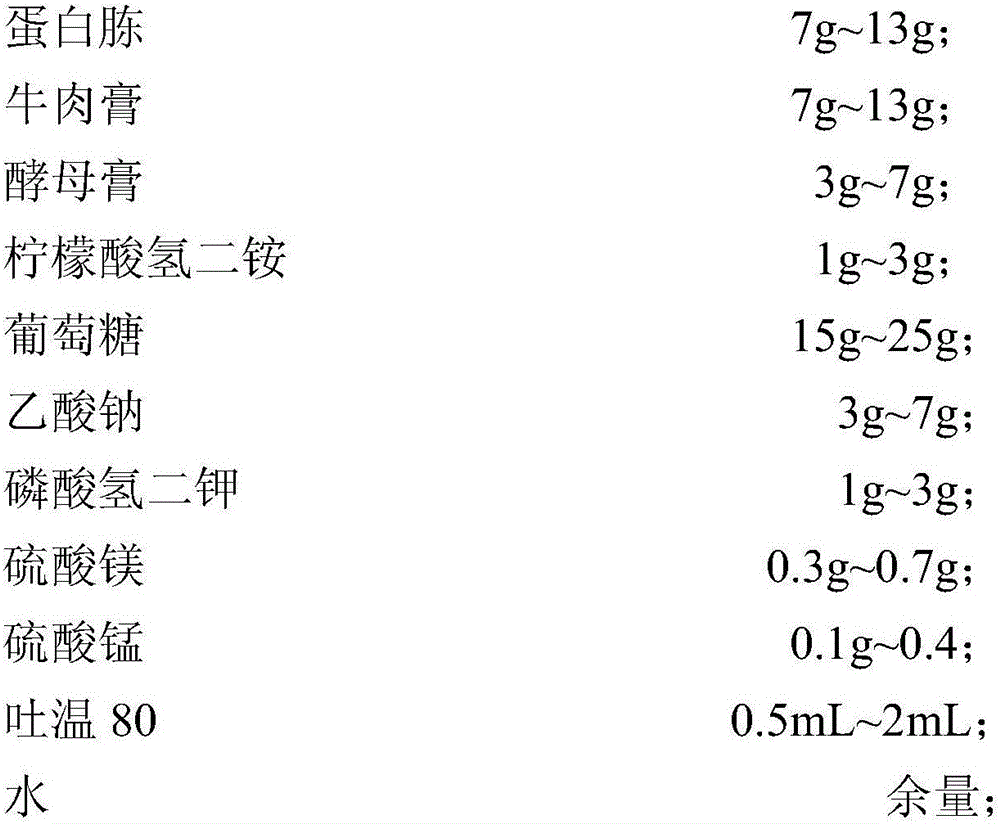Method for reducing residues of organophosphorus pesticides in Chinese wolfberry fruits with kombucha
A technology of organophosphorus pesticides and kombucha, applied in botany equipment and methods, insecticides, animal repellents, etc., can solve the problems of reducing the quality of wolfberry products and the benefits of wolfberry industry, and achieve the effect of reducing chlorpyrifos residues
- Summary
- Abstract
- Description
- Claims
- Application Information
AI Technical Summary
Problems solved by technology
Method used
Image
Examples
Embodiment 1
[0051] 1) The starting density of Saccharomyces cerevisiae CICC 33068, Acetobacter sp CICC 20441 and Lactobacillus plantarum CICC 23165 is 10 6 ~10 7 cfu / mL, respectively inoculated into liquid medium (YPD medium: peptone 20.0g, yeast extract 10.0g, glucose 20.0g, water to 1000mL; the pH value of the medium was adjusted to 6.5. AC medium: yeast extract 10.0g, glucose 10.0g, calcium carbonate 20.0g, water to 1000mL; the pH value of the medium was adjusted to 6.4. MRS medium: peptone 10.0g, beef extract 10.0g, yeast extract 5.0g, dihydrogen citrate Ammonium 2.0g, glucose 20.0g, sodium acetate 5.0g, dipotassium hydrogen phosphate 2.0g, magnesium sulfate 0.5g, manganese sulfate 0.2g, Tween 801.0mL, water to 1000mL; the pH value of the medium was adjusted to 6.0 ), the inoculation amount was 1%, and the culture was shaken at 37°C for 24 hours to obtain a bacterial suspension with a density of 10 8 ~10 9 cfu / mL.
[0052] Saccharomyces cerevisiae CICC 33068, Acetobacter sp CICC 2...
Embodiment 2
[0062] 1) The starting density of Saccharomyces cerevisiae CICC 33068, Acetobacter sp CICC 20441 and Lactobacillus plantarum CICC 23165 is 10 6 ~10 7 cfu / mL, respectively inoculated into liquid medium (YPD medium: peptone 20.0g, yeast extract 10.0g, glucose 20.0g, water to 1000mL; the pH value of the medium was adjusted to 7.5. AC medium: yeast extract 10.0g, glucose 10.0g, calcium carbonate 20.0g, water to 1000mL; the pH value of the medium was adjusted to 7.2. MRS medium: peptone 10.0g, beef extract 10.0g, yeast extract 5.0g, dihydrogen citrate Ammonium 2.0g, glucose 20.0g, sodium acetate 5.0g, dipotassium hydrogen phosphate 2.0g, magnesium sulfate 0.5g, manganese sulfate 0.2g, Tween 801.0mL, water to 1000mL; the pH value of the medium was adjusted to 6.6 ), the inoculum amount was 5%, and the culture was shaken at 37°C for 24 hours to obtain a bacterial suspension with a density of 10 8 ~10 9 cfu / mL.
[0063] Saccharomyces cerevisiae CICC 33068, Acetobacter sp CICC 2044...
Embodiment 3
[0072] 1) The starting density of Saccharomyces cerevisiae CICC 33068, Acetobacter sp CICC 20441 and Lactobacillus plantarum CICC 23165 is 10 6 ~10 7cfu / mL, respectively inoculated into liquid medium (YPD medium: peptone 20.0g, yeast extract 10.0g, glucose 20.0g, water to 1000mL; the pH value of the medium was adjusted to 7.0. AC medium: yeast extract 10.0g, glucose 10.0g, calcium carbonate 20.0g, water to 1000mL; the pH value of the medium was adjusted to 6.8. MRS medium: peptone 10.0g, beef extract 10.0g, yeast extract 5.0g, dihydrogen citrate Ammonium 2.0g, glucose 20.0g, sodium acetate 5.0g, dipotassium hydrogen phosphate 2.0g, magnesium sulfate 0.5g, manganese sulfate 0.2g, Tween 801.0mL, water to 1000mL; the pH value of the medium was adjusted to 6.3 ), the inoculum amount was 2%, and the culture was shaken at 37°C for 24 hours to obtain a bacterial suspension with a density of 10 8 ~10 9 cfu / mL.
[0073] Saccharomyces cerevisiae CICC 33068, Acetobacter sp CICC 20441...
PUM
 Login to View More
Login to View More Abstract
Description
Claims
Application Information
 Login to View More
Login to View More - R&D
- Intellectual Property
- Life Sciences
- Materials
- Tech Scout
- Unparalleled Data Quality
- Higher Quality Content
- 60% Fewer Hallucinations
Browse by: Latest US Patents, China's latest patents, Technical Efficacy Thesaurus, Application Domain, Technology Topic, Popular Technical Reports.
© 2025 PatSnap. All rights reserved.Legal|Privacy policy|Modern Slavery Act Transparency Statement|Sitemap|About US| Contact US: help@patsnap.com



